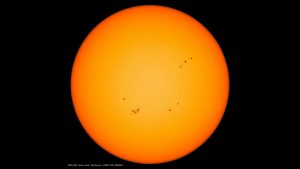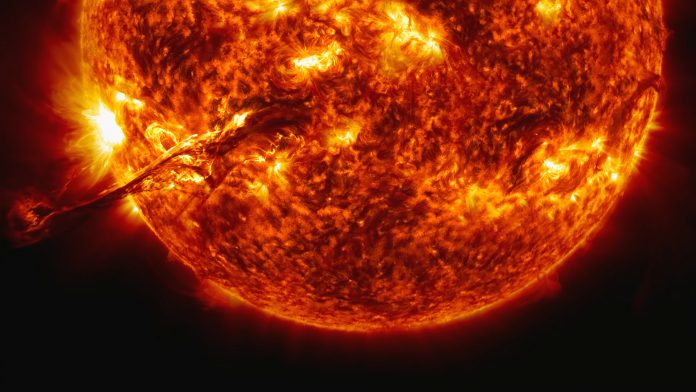Researchers have discovered a new relationship between the Sun’s magnetic field and its sunspot cycle that can help predict when the peak in solar cycles will occur.
The work, led by the Center of Excellence in Space Sciences India at IISER Kolkata, indicates that the maximum intensity of solar cycle 25, the ongoing sunspot cycle, is imminent and likely to occur within a year.
The research, ‘Discovery of a relation between the decay rate of the Sun’s magnetic dipole and the growth rate of the following sunspot cycle: a new precursor for solar cycle prediction,’ is published in Monthly Notices of the Royal Astronomical Society.
Understanding the intensity of solar cycles
The Sun is made up of hot ionised gas known as plasma, which flows to form magnetic fields inside the Sun, manifesting on the surface as dark spots. These sunspots are comparable to the size of the Earth and are seats of intense magnetism, about 10,000 times stronger than the Earth’s magnetic field.
Sometimes, sunspot magnetic fields are disrupted in violent events which result in the birth of violent solar cycles, such as flares or coronal mass ejections. These storms release high-energy radiation and hurl vast amounts of magnetised plasma into outer space.
The most intense of these storms can cause serious damage to orbiting satellites, electric power grids, and telecommunications when Earth-directed.
Solar cycles are produced by a dynamo mechanism driven by energy from plasma flows inside the Sun. This dynamo mechanism involves two primary components of the Sun’s magnetic field, one which manifests in the cycle of sunspots and another which manifests in a recycling of the large-scale dipole field of the Sun.
With the cycle of sunspots, the Sun’s dipole field is also observed to wax and wane in strength. The north and south magnetic poles also swap places every 11 years.

In 1935, Swiss astronomer Max Waldmeier discovered that the faster the rate of rise of a sunspot cycle, the stronger its strength, so stronger cycles take less time to rise to their peak intensity. This relationship has often been utilised to forecast the strength of a sunspot cycle based on observations of its early rising phase.
Discovering new patterns in solar activity
The new research discovered a new relationship: the rate of decrease in the Sun’s dipole magnetic field is also related to the rate of rise of the ongoing sunspot solar cycle.
This discovery, utilising decades-old data archives from multiple ground-based solar observatories around the world, complements the Waldmeier effect, connecting the two primary magnetic field components of the Sun.
It also supports the theory that the evolution of sunspots is integral to the functioning of the solar dynamo process rather than being just a symptom of it.
What does the research show about future cycles?
The scientists demonstrate how observations of the rate of decrease of the Sun’s dipole magnetic field can be usefully combined with sunspot observations to predict when the ongoing cycle would peak.
Their analysis suggests that the maximum of solar cycle 25 is most likely to occur in early 2024, with an uncertainty in the estimate that ranges to September 2024.
With this discovery, a new window opens up for forecasting the timing of the peak of solar cycles – when the most intense activity and most frequent space weather disturbances are expected.









